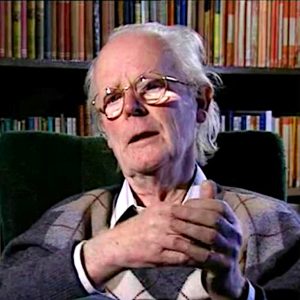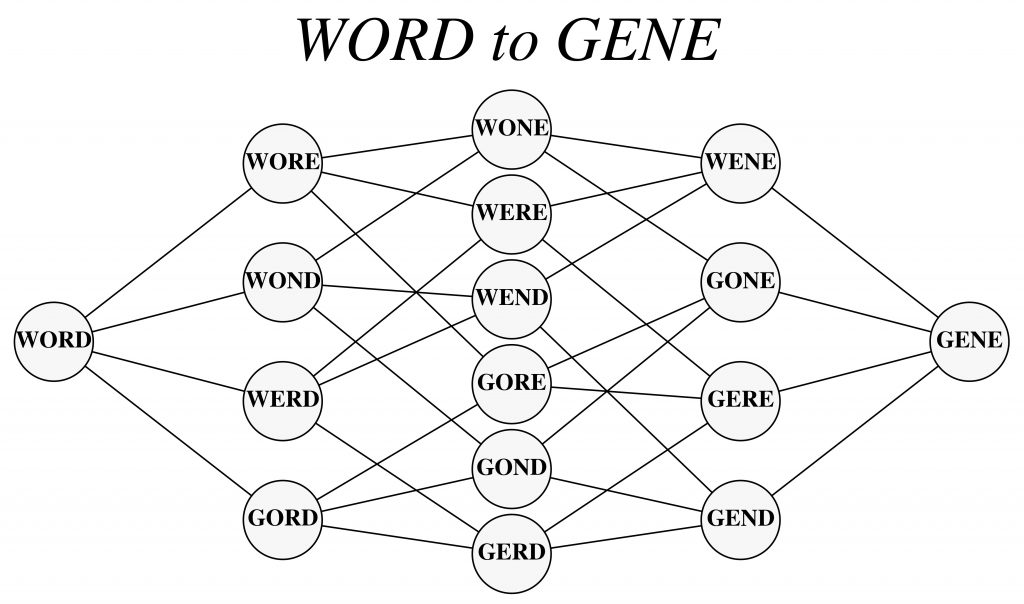Guest post by C. Brandon Ogbunugafor, Assistant Professor at Brown University.
John Maynard Smith, born in London on January 6, 1920, was one of the great iconoclasts of the post neo-Darwinian synthesis era, a cult figure whose life was defined by notable contributions across a wide breadth of subfields [1]. He not only authored numerous foundational texts in several areas of theoretical biology, he was fully engaged in the promotion of science. For example, he is well known as an ardent proponent of Darwinian evolution, a title he earned in part from his famous public debates against creationists [2].

John Maynard Smith, Wikimedia Commons
His work and career have profoundly influenced my own. I was introduced to John Maynard Smith through a concept called evolutionary game theory. I learned about it from a manuscript entitled Prisoner’s dilemma in an RNA virus by Paul Turner and Lin Chao. In it, Turner and Chao described how social dynamics between viruses infecting a cell display properties of game theory, and specifically, an example called the prisoner’s dilemma [3].
At the time (the early 2000s), Paul Turner was an Assistant Professor in the Department of Ecology and Evolutionary Biology at Yale University (now the Rachel Carson Professor of Ecology and Evolution). I was a recent college graduate, a US Fulbright Scholar studying at the International Center of Insect Physiology and Ecology in Kenya, and a soon-to-be medical student at Yale. I didn’t know anything about game theory and surely didn’t know the origin of its use in biology. Between field trips across Kenya studying mosquito ecology, I learned of these roots, soon discovering Maynard Smith’s manuscript The Logic of Animal Conflict [4]. This manuscript, written with mathematician George Price, brought ideas from game theory into the context of conflict and decision-making in ecology and evolution. Maynard Smith would later publish the authoritative text on evolution and game theory with Evolution and the Theory of Games (Cambridge, 1982) [5]. Consequently, I owe much of my early interest in virus evolution to the work of John Maynard Smith. It became my eventual dissertation topic (which I completed with Paul Turner, no less), and an area that remains a central interest of mine.
As a graduate student, I would also engage Maynard Smith’s work on evolutionary genetics [6] and the evolution of sex [7], two areas in which I was also a novice. What was most rewarding about my experiences with Maynard Smith’s work was that he used a signature style: whatever the idea, Maynard Smith used simple mathematical formalism and walked the reader through the concepts step-by-step.
While Maynard Smith’s work in game theory, evolutionary genetics, and the evolution of sex was an important part of my education, it is another of Maynard Smith’s manuscripts — a “one-off” publication (as in, one that he didn’t follow up on with a grand treatise or text) on protein evolution — that would end up directly changing my career forever. In 1970, Maynard Smith published Natural Selection and the Concept of a Protein Space [8], which introduced an analogy for understanding the incremental nature of adaptive evolution in the context of proteins. It was short, clearly-written, and wielded the power of analogy in a way that I had never seen. When I first read it, I was a graduate student studying virus evolution and evolutionary medicine and was not specifically interested in protein evolution. It wasn’t until my postdoctoral work with Daniel Hartl, where I studied the evolution of drug resistance, that I reengaged this concept in the form of the protein fitness landscape. It transformed how I understood and studied several cutting-edge topics in the evolution of drug resistance, such as higher-order epistasis between mutations in enzyme drug targets [9]. The concept of Protein Space has been so influential to me that it has inspired me to develop tools for education [10]. Now that I am an Assistant Professor, protein evolution remains an integral part of my research program, which I can connect directly to the work of John Maynard Smith.
The manuscript introducing Protein Space was published in 1970. It is fitting and especially meaningful to me that in 2020 we can celebrate both the centennial of Maynard Smith’s birth and the golden anniversary of the great manuscript that changed my career. In the April 2020 issue of GENETICS, readers can find a Perspectives article entitled A Reflection on 50 Years of John Maynard Smith’s Protein Space, in which I discuss the history and great legacy of this manuscript and the lessons it embodies [11].
While he has touched the lives of many through his work and words, Maynard Smith’s cult status derives from more than just accomplishments. His legend is colored by anecdotes that communicate a grand personality that matched the scope of his intellect. He is described as being quick-witted, sharp-tongued, and always willing to (or even preferring to) exchange thoughts over a pint of beer.
The source of my fascination with Maynard Smith may reside in how unafraid he was to engage any number of topics. Many scientists in our era, because of the practical need to secure funding and earn status as a “world expert,” can feel pressured into pruning many side interests, under the premise that these will distract us from the presumptive goal of excellence on singular topics.
While I am early in my career, I have decided to push back against this sentiment and defy it by building a research program that proudly embraces a wide number of ideas (e.g., evolutionary medicine, epidemiology, protein evolution, diversity and inclusion, etc.). I do this because I’ve concluded that what makes being a scientist enjoyable is the ability to continuously engage, feed, and grow our curiosities.
John Maynard Smith’s story signals that using curiosity and rigor as guiding lights can generate a life of scientific radiance. In perilous times, when the future of society rests in the hands of science, we should especially appreciate the legacy of those who contributed through more than their formal work. John Maynard Smith set an example that encourages future thinkers to remain vigorous, as there are many ways to positively influence others.
Citations
- Charlesworth, Brian. “John Maynard Smith: January 6, 1920–April 19, 2004.” Genetics 168.3 (2004): 1105-1109.
- Piel, Helen. “‘The Most Bogus Ideas’: Science, Religion and Creationism in the John Maynard Smith Archive.” Electronic British Library Journal 2019 (2019).
- Turner, Paul E., and Lin Chao. “Prisoner’s dilemma in an RNA virus.” Nature 398.6726 (1999): 441-443.
- Maynard Smith, John, and George R. Price. “The logic of animal conflict.” Nature 246.5427 (1973): 15-18.
- Maynard Smith, John. Evolution and the Theory of Games. Cambridge university press, 1982
- Maynard Smith, John. Evolutionary genetics. Oxford University Press, 1989.
- Maynard Smith, John. The evolution of sex. Vol. 4. Cambridge: Cambridge University Press, 1978.
- Maynard Smith, John. “Natural selection and the concept of a protein space.” Nature 225.5232 (1970): 563-564.
- Guerrero, Rafael F., et al. “Proteostasis environment shapes higher-order epistasis operating on antibiotic resistance.” Genetics 212.2
- Ogbunugafor, C. Brandon, and Daniel L. Hartl. “A new take on John Maynard Smith’s concept of protein space for understanding molecular evolution.” PLoS computational biology 12.10 (2016).
- Ogbunugafor, C. Brandon. “A Reflection on 50 Years of John Maynard Smith’s ‘Protein Space’.” Genetics 214 (2020): 749-754.
About the Author
C. Brandon Ogbunugafor is an Assistant Professor in the Department of Ecology and Evolutionary Biology at Brown University. He is an evolutionary systems biologist, and uses experimental evolution, mathematical modeling, and computational biology to better understand the underlying causes and consequences of disease, across scales: from the biophysics of proteins involved in drug resistance to the social determinants underlying disease.













